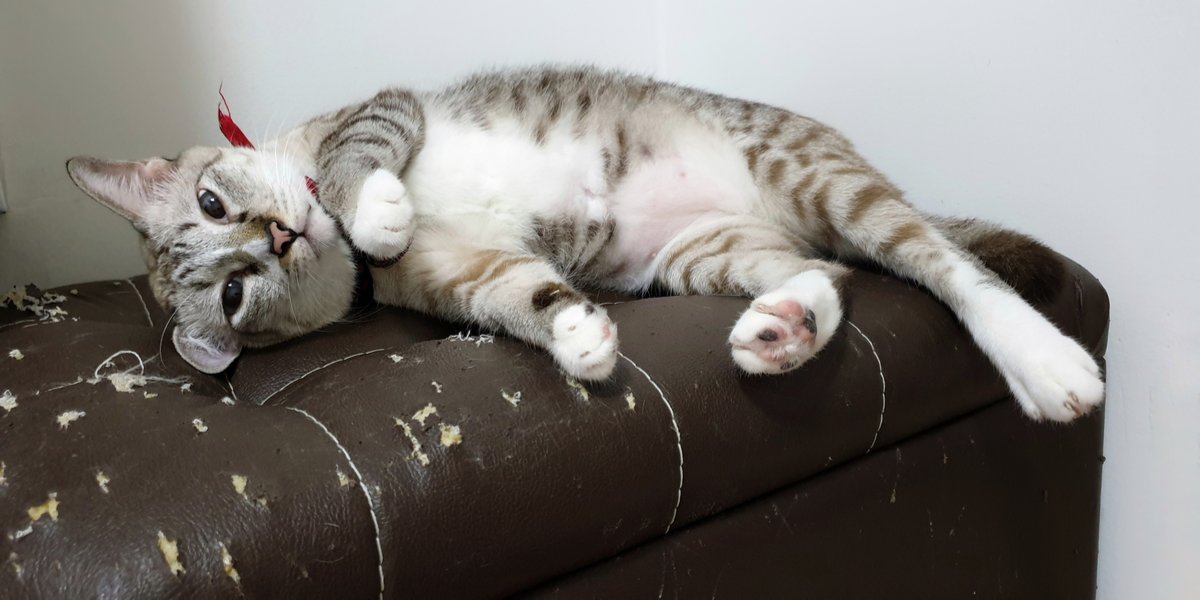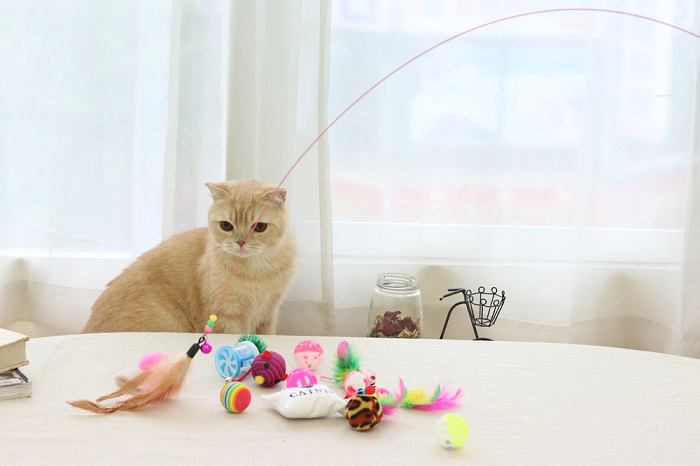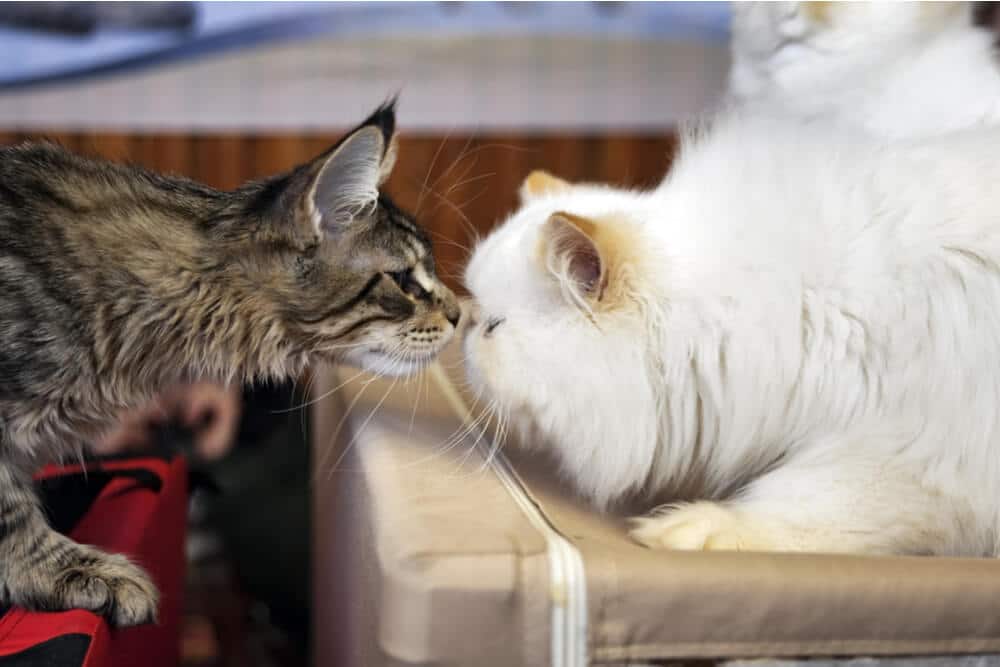
In cats, scratching is as natural and normal as sleeping, but without the right training, it can also destroy couches, chairs, and more. Fortunately, you can redirect this behavior and save both the sofa and your bond with your cat. In this article, you’ll learn how to stop your cat scratching furniture in a healthy, safe way.
Expecting our cat to stop scratching on their own is like asking them to stop breathing. The solution is not to ask them to stop scratching but to redirect the behaviour onto appropriate substrates or scratching surfaces.
Scratching at inappropriate objects or exteriors is highly annoying for cat parents. Before confronting how to stop your cat from scratching unwanted places, let’s figure out why your cat needs to scratch our furniture instead of their own.
Why Do Cats Scratch?

Cats scratch for many reasons, including:
- Excitement expression when we return after being absent all day, during playtime (a form of arousal), or as stress relief.
- Scratching flexes many of the cat’s tendons and muscles and serves as a form of exercise. Some cats also scratch after walking or as part of a stretching sequence.
- Territory marking by leaving behind visual marks through repeated scratching and by depositing chemical scent through the pads of the feet. The significance of these marks is not clear. It most likely acts as reassurance once our cat returns to investigate the spot.
- Scratching also encourages the removal of a cat’s dead nail outer cover.
Why Do Cats Scratch Furniture?
From the cat’s point of view, the couch, desk, chair, and even the wall are brilliant scratching surfaces since they are sturdy, tall, and have the right material for nail-digging.
Couches are generally in areas of social importance, which enhances their value as communication spots, serving a purpose like a message board.
Cats are likely to scratch furniture when they do not have adequate scratching options, surfaces, and substrates that do not meet their individual needs. By observing closely our kittens and cats we can determine if they find the scratching post or surface enticing enough to latch onto or if we should offer a different substrate or post type.
How To Stop Your Cat Scratching Furniture?
Learn how to stop your cat scratching furniture without ruining your relationship by following these 5 easy steps:
1. Provide Appropriate Scratching Surfaces
Cats are instinctive climbers and prefer vertical scratching posts, although some prefer horizontal ones. Vertical posts must be sturdy, tall enough for your cat to have a good stretch, and not wobbly.
A recent study found that most cats prefer rope or sisal covered posts instead of the carpeted type offered by owners, while others prefer wood, cardboard, and rough fabric.
Scratching posts must be plentiful in multi-cat households to avoid competition.
They should be placed next to your cat’s favourite spots, such as windows, the couch, entry doors, and sleeping areas since cats like to stretch after a nap.
If your home has space restrictions, consider leg wraps that protect the furniture while accommodating the cat’s needs with sisal mat wraps or do it yourself by wrapping targeted legs in a range of materials including sisal, fabric, and cotton rope.
Brushes that are wall-mounted for facial marking, food dispensers that dispense food when cats claw them, and doormats can also be used to help re-direct cats to appropriate places for marking.
Tree branches and logs are also excellent substrates for cats and can be fitted on a balcony.
Cats with orthopaedic problems can be encouraged to use one level vertical posts or horizontal scratchers as steps to jump onto higher surfaces. Discontinued carpet samples with an anti-slip rug pad (obtained from flooring stores) can provide variety of texture and non-slip scratching options for senior cats.
2. Train With Toys and Food Rewards

Tease the cat with a toy in front of the post so that when the cat takes a swipe, its claws connect with the pole. Alternatively, attach a toy (i.e. feathers, mouse) with a rope to the scratching post and encourage the cat to catch the toy.
You can also lay the scratching post on its side and rub some dried catnip leaves or powder. Catnip does not reliably attract cats to a post, so it is worth trying different substitutes, such as engaging your cat in interactive play right near a corrugated cardboard scratching pad.
Food-driven cats can be enticed with delights. Initially, reward them for sniffing and investigating the post. As they become more familiar, give a treat when they place their paws on it, working up to when they scratch it. Putting treats on top of the post will encourage climbing and delicacy retrieval.
Avoid holding your cat’s paws and rubbing them against the post, it can make them fearful and dislike the post especially if they find this type of handling scary or aversive.
Lastly, imitate the cat by scratching the post on a daily basis.
3. Apply Deterrents
Make the relevant object or surface unattractive or uncomfortable to the cat. Strong scents like citrus can be repellant to cats, so try rubbing orange or lemon peel on the furniture. You can also try spritzing it with lemon-scented sprays. Just make sure to choose a pet-safe product and know that you may have to spray often to achieve the desired effect.
Sticky tape like KatSupreme Double-Sided Deterrent Tape is sticky on both sides. You stick one side to the surface in question and peel off top sheet to turn it into a furniture protector. When your cat touches the sticky surface, he won’t like the feeling on his paws, and he’ll move elsewhere. As the tape becomes covered in fur, you’ll need to replace it to ensure efficacy.
Be mindful as well that some cats (particularly long-haired cats) may get stuck to the tape, making unpleasant hair trimming necessary.
If sticky tape isn’t enough, you can wrap the furniture in a tight-fitting sheet or even a plastic curtain. Once you’ve trained your cat to redirect his behavior to a scratching post, you can remove the deterrent.
4. Trim Your Cat’s Nails Regularly
Cats’ claws are like human fingernails and will become sharp and overgrown. Typically, cats scratch to remove old, outer layers of nails and replace them with new nail growth.
Fortnightly or monthly nail trimming will ensure your indoor cat’s nails are not thick and remain short. Outdoor cats do not require clipping since they need their claws for protection and climbing. Geriatric or arthritic cats’ nails typically require bi-monthly cutting because they are untidy and brittle due to lack of exercise and old age.
Also Read: 8 Best Cat Nail Clippers
Do not force your cat. Instead, train your cat to accept nail clipping at home! If your cat does not enjoy having its nails clipped, hire a professional cat groomer, or take them to the vet.
5. Use Cat Surface Attractant

Cats use their senses of smell to familiarize themselves with new things, including other cats.
Utilise Feliscratch by Feliway to attract your cat to an appropriate surface. Feliscratch is a pheromone that has been clinically proven to decrease or stop unwanted scratching in the home, both on vertical and horizontal surfaces. Several studies have shown that when Feliscratch is applied to a post, the cat will gravitate to that post to scratch.
Scratching is so instinctive that even cats who have endured declawing still attempt to do it.
Do not shout or punish your cat when they scrape at the wrong spot as it may cause anxiety, potentially leading to other problems.
Be patient, try several techniques and substrates for at least a few weeks and reward him or her with play, treat, or pets when he or she scratches at proper surfaces.
By considering our cat’s pattern of behaviour and communication needs, we can provide better scratching solutions that meet our individual cat and improve our human-animal bond.








Can you please email this wonderful article to me? Just got a new sofa and less than two months in, they’ve started on it. I’ve used catnip on the scratching posts and trays without much success. and cat deterrent spray. ugh. More double sided tape and a feliway diffuser on the way. Thank you!
Hello Marian
Unfortunately, we are unable to email you the article.
Sorry to hear about your sofa. Let me recommend a few more products that I have used since purchasing a new couch which minimized scratching furniture:
Over the couch cat protector https://www.amazon.com.au/NATUYA-Protectors-Protector-Cat-Cushion-Stretchable-Anti-Scratch/dp/B09F613VVB/ref=asc_df_B09F613VVB/?tag=googleshopdsk-22&linkCode=df0&hvadid=712361308463&hvpos=&hvnetw=g&hvrand=345738027073487596&hvpone=&hvptwo=&hvqmt=&hvdev=c&hvdvcmdl=&hvlocint=&hvlocphy=9071791&hvtargid=pla-1600201363179&mcid=83de83b8e2913f8a9b4e0bf5e89749c7&gad_source=1&th=1
Pet Scene Cat Scratcher Board https://www.amazon.com.au/Corrugated-Cardboard-Scratching-Scratcher-Furniture/dp/B091TB41WB/ref=sr_1_1_pp?dib=eyJ2IjoiMSJ9.nIWyvIeorAksJY5CBA8jQOvtFXksmFWiW1mUihB2RqhziugEeGJ_AKLkyRDl3yS7qT5txRnSAwc3cmeu03mmJw0F_7SHNXXF_4VCWexSe0OwBfMrN2QnbDFp9PO5JtmpOeJqB6WGDhapYJp1TJVqKKSW7dGSLkOakFXKzoMqG5PE5rv20VQuRuf0DKCdxZosuk0CNP3-36dKZgXBImAzJalYfI2OO3HzUrBXFNuGBM8gul4asjiPXCdkqXQhtdJcwZlEukiVGOAowQ1KF9CtGmgvygDRj7a4xQLYFfN3EdaVQIYWaiEP9SYESJ1SXixrRTte7zAfQxR9HkLRh52ifE016YEGwUWw2KixXdMFkXeckrnEH8erY7kS3ctnKKhEOfY746advvPlz-D6AQp4QPvxuAmGDmYAE12ccinlcb5HTS3WDWW7_NsbUJNRJhfv.-b_fB2Pjdt2NI_W8maUDLQVxqP0tdeA80yo1cglIDgE&dib_tag=se&keywords=cat+scratcher+cardboard&qid=1736811345&s=computers&sr=8-1
I hope this helps
Melina
We are redecorating our flat and are looking for a solution to this dilemna. We have four cats. The interior designer has shown us so really attractive, catproof upolstery textiles which we are considering for a sofa and armchairs. She has had cats herself and swears by them. As for the curtains, we will probably go with something less expensive which we can replace every year or two if necessary.
Hi Robert,
Sounds like you have a few fantastic ideas.
It seems like you have some great ideas! You might consider adding corrugated paper 8-shaped cat scratch boards, ScratchProtect™ transparent furniture protectors for cats, or cat scratch mat sofa protectors to your collection.
Have fun decorating!
Melina
i bought a spray bottle, filled with water and put on ‘stream’ shot. instead of a light spray it shoots out fast
all i have to do is reach for that bottle and Dunkin quickly stops scratching
Hi Nancy,
Thank you for reading our article and for your feedback.
Unfortunately, instead of teaching your cat to move towards an incentive, the spray bottle teaches your cat to move away from something unpleasant. The spray bottle is aversive to the cat because it produces water, which cats dislike. It also makes a sound like a ‘cat hissing’.
Additionally, when the punishment is connected to the person spraying the bottle, the cat will likely associate the unpleasant event with that person, potentially breaking the bond between you and your cat.
Instead, why not teach your cat that good things happen when using the scratcher with food rewards or stroking? Work towards rewards, not away from aversives.
All the best,
Melina
I have tried the double sided sticky tape and my cat just loves it, She will lick it and pull it off of furniture and window screens. Crazy!
Thank you for your feedback, Mary.
Perhaps it’s worth trying a different method or a remedy which can be sprayed on the furniture. Your kitty is a unique, quirky girl.
Melina
Is there a printable version of just the words without the pictures? i would love to add this article into my adoption packets for new adopters?
Hi Coly,
Thank you for reading our article.
I will get in touch with you by email shortly.
All the best,
Melina
I just found out cats detest microfiber material. A dear friend said her cat had destroyed a lot of their chairs etc. Upholstery person advised the microfiber & cats are not touching it!!
Feliscratch has been discontinued by Feliway.
ohh what a shame, thank you for letting us know Nicholas.
My 3 year old cat scratches the couch to get my attention. I have numerous scratching posts, including a cat tree. I tried a cat deterrent spray, and double sided tape, but they only worked for a short time.
Hi Monica, sorry to hear those methods haven’t worked! If your cat is scratching for attention, he might be bored and need a little more interactive play time. You could try a puzzle feeder or a treat-dispensing ball to pique his interest. There’s no substitute for good old-fashioned playtime, though. Even a few minutes a few times a day works which is sometimes easier to work into a busy schedule than longer playtimes.
I have a senior female cat who is a dear, Although she is not using a scratch pad of which we have many different
sizes. She is using one chair instead.
I have read your article and wonder if anything I have written suggests additional information.
Appreciate your additional help should their be anything to add.
All best,
Shirley Davis\San Francisco
Dear Shirley
Thank you so much for reading our article.
Since senior cats are less likely to use a vertical scratching post, alternative scratching substrates should be provided for exercise plus scratching such as corrugated iron scratcher, floor mats or carpet off cuts.
To minimize damage to the chair, you can purchase a furniture protector on amazon; https://www.amazon.com.au/s?k=chair+scratcher+protector&i=pets&crid=6IHMZT55NOJR&sprefix=chair+scratcher+protector%2Cpets%2C239&ref=nb_sb_noss
Hope this helps with long term care of your dear cat
Have a lovely day
Melina
I have a cat that started clawing on the wall next to my bed (no option to move bed). She actually has pulled the paint off in several spots in the same area.
I’ve put large pillows along the side of the bed along the wall. Any suggests?
I have a scratching post in the room.
Thanks
Hi Bets,
I’m sorry to hear your cat started clawing on the wall recently. It could be a sign of boredom, distress, frustration, overgrown nails, unhappy with existing post or territorial marking. Another weird explanation the cat may be hearing sounds of pests within the wall cavity.
Here are few suggestions of how to stop her clawing the wall (try to pin point the reason first): 1. Relocate or replace your scratching post with a tall, wall mounted one at the exact location. 2. Plug in a Feliway diffuser in the bedroom. 3. Spray a citrus deterrent on the wall. 4. Provide extra enrichment and stimulation to reduce boredom. 5. Trim her nails. 6. If there are other cats within the household, reduce inter-cat conflict 7. Reduce stress. 8. Lastly, if nothing works, arrange a pest control.
Hope this helps, keep us posted
Melina
Hi Yvonne, I have two cats, an 8 and a half year old male that I adopted when he was three months old and a 1 and a half year old female I rescued from the woods last November. I have the figure 8 scratching board that lies on the floor and I have a 28″ stand up sisal rope scratching post. While they do use the two scratching posts, their favorite place to scratch is on the walls beside my doors: closet door, bathroom door, bedroom door, etc. How do I get them to stop scratching the walls and just use the posts? I live in an apartment and can only imagine what i will be charged for repairing the walls when I move! Help! Thanks.
Hi Christy
Melina here from the Behaviour Team, thank you for your question and sorry to hear about the walls. Most likely they scratch the walls to mark their territory by depositing chemicals. I would increase the number of posts in your home to include additional horizontal and vertical posts as well as substrates preferred by each individual cat positioned in prominent areas and in vicinity of the below mentioned walls whilst redirect both cats with a FELISCRATCH by FELIWAY https://www.feliway.co.uk/products/feliway-classic-spray?variant=42479639691415 or with toys or catnip. I also recommend purchasing a tall cat tree or cat playground suitable for multi-cat homes as well as ensure both cats have separate resources to minimize rivalry and conflict (i.e. 2 beds, 2 puzzle feeders, lots of toys, multiple boxes, etc). Hope this helps, keep us posted.
I have brother cats I got from a rescue when they were 12 weeks old. They are now 1 1/2 years old. The larger brother is attracted to art on my walls and scratches on them and tries to bring them down. Anyone else have this problem?
Hi Yvonne, I’ve not heard of anything exactly like this, but it sounds like your cat may be attracted to the texture or perhaps even the smell of the wall art. You may want to use some kind of deterrent (like the Psst! deterrent spray can) to direct your cat away from it. You can also apply some of the tips in this article on keeping cats off of counters. Hope this helps!
Hi Yvonne, I had a similar problem with my male cat. As Mallory pointed out, he was attracted to the texture. I relocated the artwork to a higher surface and added both vertical and horizontal scratching options that matched his scratching preference.
Hello! Hope I’m in the right spot for this, but I need info on kittens. I have a new baby, she’s 8-9 weeks old now, I’ve had her since she was 3 or 4 weeks. Someone dumped her off in my yard, a tiny, lost little calico furball, hungry and so not weaned!
I keep puppy and kitten milk replacer on hand ( it’s good for lots of different babies), along with nursing bottles, and we got going on that straight off and she did really well. She is weaned and on kitten kibble now, but it’s just been so many years since I’ve had a kitten to raise all the way. My other cats arrived all around a year or more old, so I’m very out-of-practice with the little ones. I especially need info on not letting them develop bad habits (which she seems to be doing) like scratching and clawing, climbing up your legs and biting your face and fingers. Not gently! If it’s a normal phase kittens go through and outgrow, great! But if not, I need to know how to break her of this behavior while I still have a face and hands to work with. Parts of me look literally like raw hamburger. Seriously. This isn’t meanness, just rough play, but I don’t know how to stop it.
Any and all information and/or advice will be greatly appreciated.
Sincere thanks,
Karen Sullivan
Hi Karen,
You’re in the right spot for behavioral advice for your little calico fur-ball – she is a lucky kitty to have you as her cat parent.
Unfortunately, there is little documentation on the effects of hand rearing processes on behavioral development which highlights the need for further research in this area, however, to ensure weaning occurs in a behaviorally appropriate manner, owners should address the following key functions:
A. Gradual and/or delayed weaning – whenever possible, kittens should be continuously kept with their mother or a surrogate mum. Some research suggests that delayed weaning improves the quality of a cat’s life and reduces stereotypical behavior including aggression. Kittens should also remain with their siblings to minimize risk of developmental psychological abnormalities, nervousness and aid with coping mechanism in novel situations and environments.
B. Socialization and habituation – this is especially important time to ensure offspring’s grow into confident, well-adjusted adult cats. Kittens should be introduced to humans, children and other animals as soon as possible. Gentle human contact through frequent handling and novel experiences are crucial at the sensitive period. Habituation is also a vital process by which kittens are progressively and quietly exposed to sights, sounds, tastes, smells and textures in the home environment ranging from introduction to the TV, music sounds, vacuum cleaner, variety of furniture and car trips.
C. Feeding choices and litter preference – although more research is required, it’s been recognized that cats establish olfactory preferences during early life with the perinatal exposure having the strongest effect. Feed variety of food to avoid fussy eaters. Litter substrate preference is also influenced by the litter type used by the queen and her offspring’s, so please keep that in mind if making future changes.
D. Play and predatory behavior – during the weaning period kittens will shift from nursing to eating prey. They also learn social and hunting skills by playing with their siblings. They will start to display predatory behavior by capturing prey. To avoid misdirected play/predatory attention seeking behavior or deal with misplaced play/predatory aggression teach your kitten to play appropriately from a young age by redirecting onto inanimate objects such as ping pong balls and ‘fishing rod’ toys where a person moves a wand, but the cat chases the toy on the end of the wand, instead of hands/feet. Likewise rotate toys and avoid stroking or picking your kitten during or after playtime as it might unintentionally encourage your kitten to think hands are toys.
E. Scratching and clawing – introduce a sturdy upright scratching post (less than 1m) and train your cat to claw at the pole with these few simple tips (https://www.petnurture.com.au/tips-for-training-a-cat-to-use-a-scratching-post/).
I also recommend reading an article written by International Cat Care named Bringing up a litter of kittens: behavioral considerations (https://icatcare.org/advice/bringing-up-a-litter-of-kittens-behavioural-considerations/) and enrolling in Kitten Kindergarten classes in your area for added socialization.
Hope this helps, please keep us posted on your progress.
This has to do with my cat scratching my window screens on the outside trying to get in. How can I stop him from doing this.
Hi Susan,
Thank you for your recent question.
It’s important to find out the motivation for your cat’s behavior. Since I’m unaware of his previous experiences or if you had from kitten hood. If he was re-homed, is it possible he used to gain access from a window sill in his previous household?
I need to establish if he has a cat flap or another access point to enter/exit the home. If you do, perhaps he feels unsafe or fearful of the current set up, try seeing it from his perspective, get down low.
Another reason could be he is trying to gain your attention which is probably reinforced by your response.
To prevent him from scratching window screens try the following:
1. Train him to use the correct entry/exit point.
2. Ignore him, walk away and don’t respond to the unwanted behavior – avoid rewarding negative behavior.
3. Clicker train with a cue like ‘down’ or ‘off’.
3. Deter him by sticking a double-sided tape on the window screen.
4. Reward him when he uses the correct entry/exit point with treats or interactive play.
5. If all else fails, replace the screen with a pet door or restore the screen to a pet proof mesh.
Hope this helps, let us know if you had any success, Melina
Very informative, and useful. I love the readings.